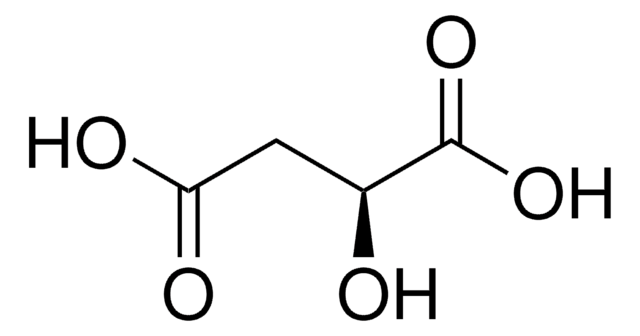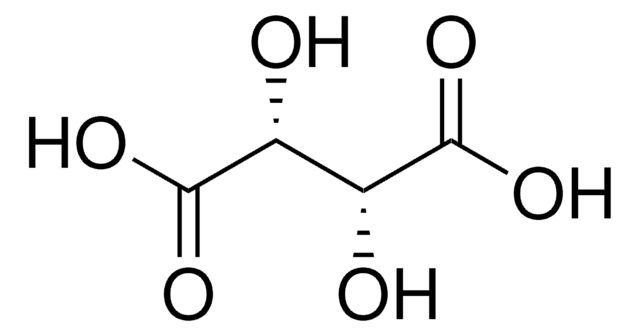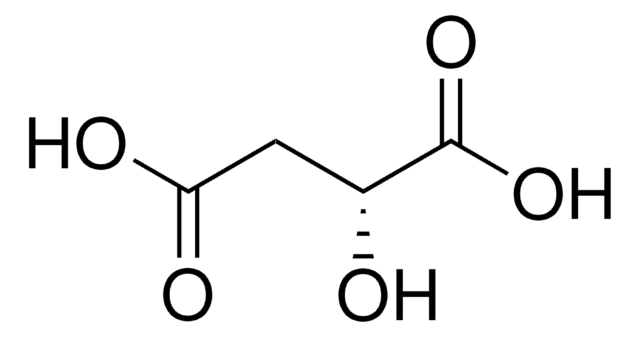27606
DL-Malic acid
meets analytical specification of FCC, E296, 99-100.5% (alkalimetric)
Sinonimo/i:
(±)-2-Hydroxysuccinic acid, DL-Hydroxybutanedioic acid
About This Item
Prodotti consigliati
Densità del vapore
4.6 (vs air)
Tensione di vapore
<0.1 mmHg ( 20 °C)
Saggio
99-100.5% (alkalimetric)
Stato
solid
Attività ottica
[α]/D −0.10 to +0.10°
Temp. autoaccensione
644 °F
Qualità
meets analytical specification of FCC, E296
tecniche
IR spectroscopy: suitable
Impurezze
≤0.05% maleic acid
≤0.1% water insoluble matter
≤1% fumaric acid
Residuo alla calcinazione
≤0.1% (as SO4)
Punto di fusione
129-133 °C
131-133 °C (lit.)
Solubilità
acetone: soluble 17.75 g/ 100 gm at 20 °C
diethyl ether: soluble 0.84 g/100 gm at 20 °C
dioxane: soluble 22.70 g/100 gm at 20 °C
ethanol: soluble 45.53 g/100 gm at 20 °C
methanol: soluble 82.70 g/100 g at 20 °C
water: soluble 55.8 g/100 gm at 20 °C
benzene: insoluble
Cationi in tracce
As: ≤3 mg/kg
Hg: ≤1 mg/kg
Pb: ≤2 mg/kg
Compatibilità
complies for identity (IR)
applicazioni
pharmaceutical (small molecule)
Stringa SMILE
OC(CC(O)=O)C(O)=O
InChI
1S/C4H6O5/c5-2(4(8)9)1-3(6)7/h2,5H,1H2,(H,6,7)(H,8,9)
BJEPYKJPYRNKOW-UHFFFAOYSA-N
Cerchi prodotti simili? Visita Guida al confronto tra prodotti
Applicazioni
Azioni biochim/fisiol
Avvertenze
Warning
Indicazioni di pericolo
Consigli di prudenza
Classi di pericolo
Eye Irrit. 2
Codice della classe di stoccaggio
11 - Combustible Solids
Classe di pericolosità dell'acqua (WGK)
WGK 1
Punto d’infiammabilità (°F)
397.4 °F
Punto d’infiammabilità (°C)
203 °C
Dispositivi di protezione individuale
dust mask type N95 (US), Eyeshields, Gloves
Scegli una delle versioni più recenti:
Possiedi già questo prodotto?
I documenti relativi ai prodotti acquistati recentemente sono disponibili nell’Archivio dei documenti.
I clienti hanno visto anche
Il team dei nostri ricercatori vanta grande esperienza in tutte le aree della ricerca quali Life Science, scienza dei materiali, sintesi chimica, cromatografia, discipline analitiche, ecc..
Contatta l'Assistenza Tecnica.





